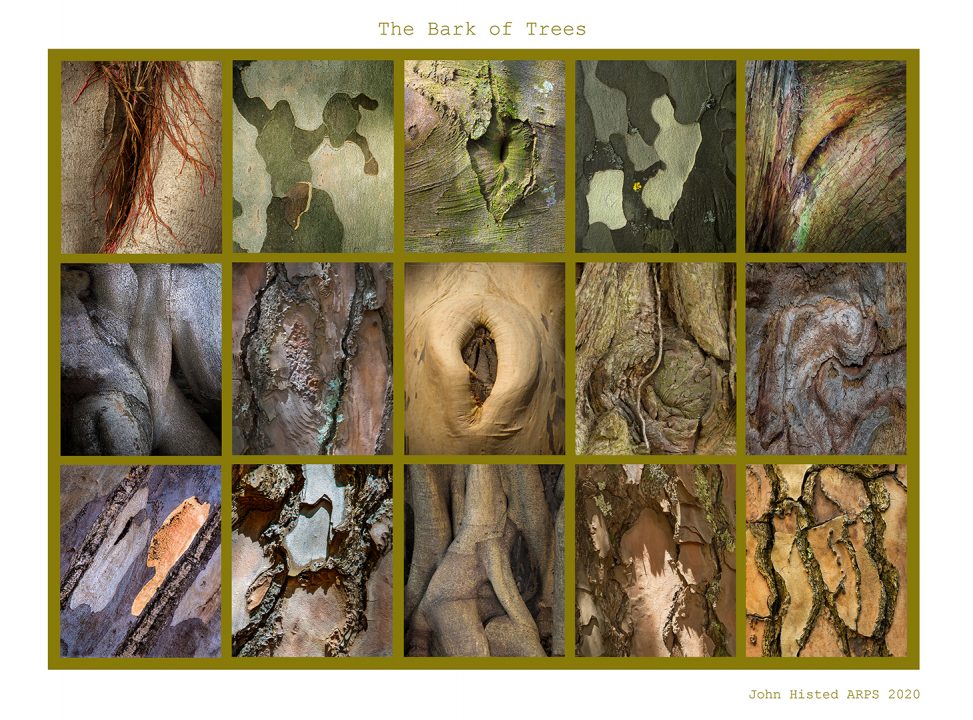We are very proud of our member John on achieving his ARPS. This stands for Associate of the Royal Photographic Society. It is one of their photographic qualifications and not easy to achieve. The image above show the fifteen photographs that made up the panel that John had to put together. We wanted to know how he approached this difficult task and what the inspiration was.
Below John answers our questions and shines a light on what made him attempt this .
Not only that John has also given us the individual images, together with the hanging plan and statement of intent, which we hope will help any of you considering something similar. To see these you can go straight to John’s ARPS Gallery HERE
John Histed answers our questions.
How did you first become involved with photography?
My father bought me a camera when he returned home after the war. He also taught me how to develop film and produce contact prints.
What is it that interests you about photography?
As a person I am much more stimulated by pictures rather than words or sounds. I remember some pictures for years but I have to work hard to remember words and music (a complete mystery). Photography gives me the ability to make pictures without any of the skills of a draftsman. At school I was interested in chemistry, physics and maths which fitted well with darkroom work and managing the camera.
What do you like about camera clubs?
Camera clubs give an introduction to a group of photographically minded people.
I have benefited greatly from my membership of the SPS in the advice given to me by many members, and in giving me a wide range of images to look at.
What interested you in the ARPS awards that have given you the letters after your name and what was involved?
To become an ARPS you have to submit a body of photographic work to be independently judged against an established and coordinated internationally recognised standard.
A brief timeline of how I decided to submit a panel of prints for the ARPS will put this in perspective.
Until the mid 70s I did a lot of monochrome print work. Eventually family and business intervened and I no longer found the time to think about photography.
This left a lot of unfinished work and ideas.
Fifteen years later when teaching my daughter to process film and make prints in a darkroom I realised how I had lost the skill to produce quality prints. When I retired I went on a course to try and recapture and develop my skills. This did not work and I joined the SPS and Calne Camera Club hoping that meeting present day photographers would help. It did! I entered competitions keenly but learned very little from them. Most of what I learnt at this time was from more senior members who saw me struggling. I looked around for technical college courses that would give me a suitable level and breadth of technical grounding. None of the courses seemed right. I was made aware of the LRPS which requires the submission of a panel of ten good quality images which demonstrate a range of camera and processing techniques and is independently assessed to a widely recognised standard. I took some sample prints to an advisory day when I learnt much more about making digital prints than I had from entering competitions.
I prepared and then submitted a panel for LRPS.
I still did not feel adequately grounded in digital photography. Colleagues directed me to the PAGB qualifications, which, when I considered them, seemed heavily weighted towards producing individual images that judges would like. I have always been strongly project orientated. To me, the ARPS seemed capable of being the basis of a suitable project using prints. The requirements include a Statement of Intent which states the objective as well as a panel fifteen good quality prints that completely fulfil the objective and form a coherent whole.
It has taken me about four years to achieve this but I was delayed for medical reasons. Some do it in less than one year.
The RPS offers both on-line and face to face advisory services both of which I used. I also depended heavily on the input and advice from various SPS members and others. I would particularly like to thank Eddy Lane, Chris Pocock, Terry Walters, Robert Albright, Malcolm Cole, Shirley Williams and other members for their helpful input.
Have you a particular photograph that you are looking forward to taking?
I would like to capture the essence of the seasons but this year I have hardly had my camera out.
So, what’s next?
I am currently thinking of what my next project should be. I am interested in the idea of assembling books of photographs. I still have unfinished work from the seventies. On the other hand so much happens in the wider countryside. In short, I’m still thinking.
Thanks John and good luck with the next project.

Malcolm Cole
Congratulations John
Seeing your final panel, as small thumbnails on the website, reminded me of how I felt when we first talked about your project. Trees & timber have always inspired me and your images rang a lot of bells in my head. I enjoy SPS’s Series Competition and whilst not the Herculean task of an ARPS panel, it does involve similar decisions. Let hope our individual future projects continue to encourage us and inspire others in photography.
Thank you for allowing me to view your work, the pleasure was all mine.